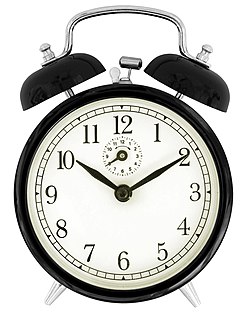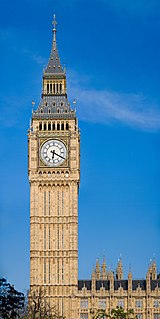Related Research Articles

St Mary Redcliffe is an Anglican parish church located in the Redcliffe district of Bristol, England. The church is a short walk from Bristol Temple Meads station. The church building was constructed from the 12th to the 15th centuries, and it has been a place of Christian worship for over 900 years. The church is renowned for the beauty of its Gothic architecture and is classed as a Grade I listed building by Historic England. It was famously described by Queen Elizabeth I as "the fairest, goodliest, and most famous parish church in England."
The Westminster Quarters, from its use at the Palace of Westminster, is a melody used by a set of four quarter bells to mark each quarter-hour. It is also known as the Westminster Chimes, Cambridge Quarters or Cambridge Chimes from its place of origin, the Church of St Mary the Great, Cambridge.

A cuckoo clock is, typically, a pendulum clock that strikes the hours with a sound like a common cuckoo call and has an automated cuckoo bird that moves with each note. Some move their wings and open and close their beaks while leaning forwards, whereas others have only the bird's body leaning forward. The mechanism to produce the cuckoo call has been in use since the middle of the 1700s and has remained almost without variation.
A grandfather clock is a tall, freestanding, weight-driven pendulum clock with the pendulum held inside the tower or waist of the case. Clocks of this style are commonly 1.8–2.4 metres (6–8 feet) tall with an enclosed pendulum and weights suspended by either cables or chains which have to be calibrated occasionally to keep the proper time. The case often features elaborately carved ornamentation on the hood, which surrounds and frames the dial, or clock face. The English clockmaker William Clement is credited with the development of this form in 1670. Until the early 20th century, pendulum clocks were the world's most accurate timekeeping technology, and longcase clocks, due to their superior accuracy, served as time standards for households and businesses. Today they are kept mainly for their decorative and antique value, having been widely replaced by both analog and digital timekeeping.

A music box or musical box is an automatic musical instrument in a box that produces musical notes by using a set of pins placed on a revolving cylinder or disc to pluck the tuned teeth of a steel comb. The popular device best known today as a "music box" developed from musical snuff boxes of the 18th century and were originally called carillons à musique. Some of the more complex boxes also contain a tiny drum and/or bells in addition to the metal comb.

An alarm clock is a clock that is designed to alert an individual or group of individuals at a specified time. The primary function of these clocks is to awaken people from their night's sleep or short naps; they are sometimes used for other reminders as well. Most use sound; some use light or vibration. Some have sensors to identify when a person is in a light stage of sleep, in order to avoid waking someone who is deeply asleep, which causes tiredness, even if the person has had adequate sleep. To turn off the sound or light, a button or handle on the clock is pressed; most clocks automatically turn off the alarm if left unattended long enough. A classic analog alarm clock has an extra hand or inset dial that is used to specify the time at which the alarm will ring. Alarm clocks are also used in mobile phones, watches, and computers.
A repeater is a complication in a mechanical watch or clock that chimes the hours and often minutes at the press of a button. There are many types of repeater, from the simple repeater which merely strikes the number of hours, to the minute repeater which chimes the time down to the minute, using separate tones for hours, quarter hours, and minutes. They originated before widespread artificial illumination, to allow the time to be determined in the dark, and were also used by the visually impaired. Now they are mostly valued as expensive novelties by watch and clock enthusiasts. Repeaters should not be confused with striking clocks or watches, which do not strike on demand, but merely at regular intervals.

A striking clock is a clock that sounds the hours audibly on a bell or gong. In 12-hour striking, used most commonly in striking clocks today, the clock strikes once at 1:00 am, twice at 2:00 am, continuing in this way up to twelve times at 12:00 mid-day, then starts again, striking once at 1:00 pm, twice at 2:00 pm, up to twelve times at 12:00 midnight.
Simon Willard was a celebrated American clockmaker. Simon Willard clocks were produced in Massachusetts in the towns of Grafton and Roxbury, near Boston. Among his many innovations and timekeeping improvements, Simon Willard is best known for inventing the eight-day patent timepiece that came to be known as the gallery or banjo clock.

The ringing of a school bell announces important times to a school's students and staff, such as marking the beginnings and ends of the school day, class period, and breaks.

A steam clock is a clock which is fully or partially powered by a steam engine. Only a few functioning steam clocks exist, most designed and built by Canadian horologist Raymond Saunders for display in urban public spaces. Steam clocks built by Saunders are located in Otaru, Japan; Indianapolis, United States; and the Canadian cities of Vancouver, Whistler and Port Coquitlam, all in British Columbia. Steam clocks by other makers are installed in St Helier, Jersey and at the Chelsea Farmers' Market in London, England.

Aaron Willard was an entrepreneur, an industrialist, and a designer of clocks who worked extensively at his Roxbury, Massachusetts, factory during the early years of the United States of America.

A chime or set of chimes is a carillon-like instrument, i.e. a pitched percussion idiophone consisting of 22 or fewer cast bronze bells. Chimes are primarily played with a keyboard, but can also be played with an Ellacombe apparatus. Chimes are often automated, in the past with mechanical drums connected to clocks and in the present with electronic action. Bellfounders often did not attempt to tune chime bells to the same precision as carillon bells. Chimes are defined as specifically having fewer than 23 bells to distinguish them from the carillon. American chimes usually have one to one and a half diatonic octaves. According to a recent count, there are over 1,300 existing chimes found throughout the world. Almost all of them are located in the Netherlands and the United States, and other countries in Western Europe.

Big Ben is the nickname for the Great Bell of the striking clock at the north end of the Palace of Westminster in London, England, and the name is frequently extended to refer also to the clock and the clock tower. The official name of the tower in which Big Ben is located was originally the Clock Tower, but it was renamed Elizabeth Tower in 2012 to mark the Diamond Jubilee of Elizabeth II.

St Wulfram's Church, Grantham, is the Anglican parish church of Grantham in Lincolnshire, England. The church is a Grade I listed building and has the second tallest spire in Lincolnshire after Louth's parish church.

John Ellicott, was an eminent English clock and watchmaker of the 18th century.

The Kremlin Clock or Kremlin Chimes, also known colloquially in the West as Moscow Clock Tower, is a historic clock on the Spasskaya Tower of Moscow Kremlin. The clock dial is above the main gates to Red Square. For decades, the chimes have rung on the quarter-hour, with bells tolling for each full hour.

The Chamberlain Clock is an Edwardian, cast-iron, clock tower in the Jewellery Quarter of Birmingham, England. It was erected in 1903 to mark Joseph Chamberlain's tour of South Africa between 26 December 1902 and 25 February 1903, after the end of the Second Boer War. The clock was unveiled during Chamberlain's lifetime, in January 1904 by Mary Crowninshield Endicott, Joseph Chamberlain's third wife.

Robert Wemyss Symonds FRIBA was a British architect, and "the pre-eminent 20th century scholar and authority on English furniture". His complicated love life, before he married respectably, included affairs with two women, the first of which produced children he never acknowledged, and the second with a woman who he discovered was already married and who was subsequently jailed for perjury in her divorce case.
The Seymour tall case clock in the White House, more commonly known as the Oval Office grandfather clock, is an 8 feet 10 inches (269 cm) longcase clock, made between 1795 and 1805 in Boston by John and Thomas Seymour, and has been located in the Oval Office since 1975. Since the presidency of Gerald Ford it has remained one of the few constant features in the office, throughout several renovations.
References
- ↑ Antique Long Case Mahogany Clocks
- ↑ "John Benson". Regent Antiques. 5 August 2016. Retrieved 11 September 2022.